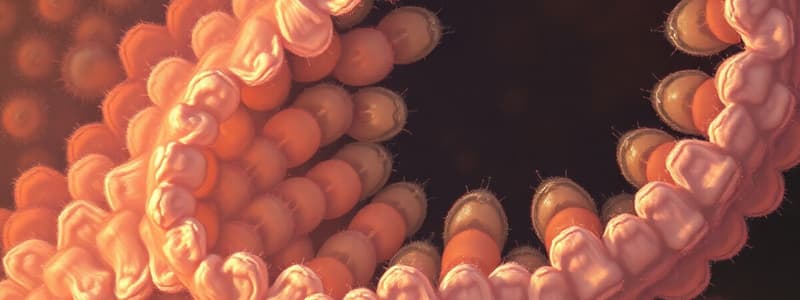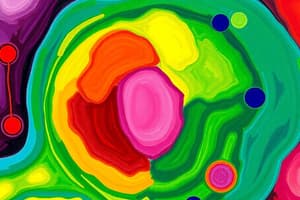Podcast
Questions and Answers
Which organelle is responsible for degrading and recycling unnecessary macromolecules into building blocks?
Which organelle is responsible for degrading and recycling unnecessary macromolecules into building blocks?
- Smooth Endoplasmic Reticulum (SER)
- Rough Endoplasmic Reticulum (RER)
- Lysosome (correct)
- Mitochondria
During which phase do homologous chromosomes move toward opposite poles in a dividing cell?
During which phase do homologous chromosomes move toward opposite poles in a dividing cell?
- Mitosis
- Fertilization
- Meiosis I (correct)
- Binary Fission
What complex of proteins is nuclear DNA associated with, which condenses during cell division?
What complex of proteins is nuclear DNA associated with, which condenses during cell division?
- Chromatids
- Chromatin (correct)
- Chromophores
- Chromosomes
How does active transport differ from passive transport?
How does active transport differ from passive transport?
What type of process is ATP hydrolysis considered to be?
What type of process is ATP hydrolysis considered to be?
What characteristic distinguishes cancer cells from normal cells?
What characteristic distinguishes cancer cells from normal cells?
What role does the mitochondrial inner membrane play in cellular respiration?
What role does the mitochondrial inner membrane play in cellular respiration?
What is the primary function of pancreatic cells in relation to blood glucose levels?
What is the primary function of pancreatic cells in relation to blood glucose levels?
Which statement about the cell cycle is not true?
Which statement about the cell cycle is not true?
What is reduced in the following reaction: Pyruvate + NADH + H^+ ↔ Lactate + NAD^+?
What is reduced in the following reaction: Pyruvate + NADH + H^+ ↔ Lactate + NAD^+?
What process is primarily responsible for ATP synthesis during oxidative phosphorylation?
What process is primarily responsible for ATP synthesis during oxidative phosphorylation?
How does specific cyclin regulate cell division cycle progression?
How does specific cyclin regulate cell division cycle progression?
What is the primary difference between cellular respiration and fermentation?
What is the primary difference between cellular respiration and fermentation?
What property of ion channel proteins allows specific ions to pass through the cell membrane?
What property of ion channel proteins allows specific ions to pass through the cell membrane?
Which type of inhibition does ascorbic acid demonstrate by being similar in size and shape to catechol?
Which type of inhibition does ascorbic acid demonstrate by being similar in size and shape to catechol?
Which of the following processes does not occur in the mitochondria of eukaryotic cells?
Which of the following processes does not occur in the mitochondria of eukaryotic cells?
What best describes the relationship between photosynthesis and respiration?
What best describes the relationship between photosynthesis and respiration?
Why do plants release O2 during photosynthesis?
Why do plants release O2 during photosynthesis?
In a scenario where a selectively permeable membrane encloses an aqueous solution, what type of solution is likely found outside the cell if it allows water and certain monosaccharides to pass?
In a scenario where a selectively permeable membrane encloses an aqueous solution, what type of solution is likely found outside the cell if it allows water and certain monosaccharides to pass?
What role do polar amino acids play in ion channel proteins?
What role do polar amino acids play in ion channel proteins?
Which of the following statements about ATP production during photosynthesis and respiration is true?
Which of the following statements about ATP production during photosynthesis and respiration is true?
Which two organelles are primarily involved in the secretory pathway of pancreatic cells?
Which two organelles are primarily involved in the secretory pathway of pancreatic cells?
What is the primary function of oxygen gas in human mitochondria?
What is the primary function of oxygen gas in human mitochondria?
Which statement about channels and transporters is incorrect?
Which statement about channels and transporters is incorrect?
In glycolysis, what is produced for every glucose molecule processed?
In glycolysis, what is produced for every glucose molecule processed?
Which process is not a type of endocytosis?
Which process is not a type of endocytosis?
Which term correctly completes the analogy: Catabolism is to anabolism as
___ is to ___?
Which term correctly completes the analogy: Catabolism is to anabolism as ___ is to ___?
What is the purpose of exergonic redox reactions in the mitochondrial inner membrane?
What is the purpose of exergonic redox reactions in the mitochondrial inner membrane?
Which statement best describes the process of passive transport?
Which statement best describes the process of passive transport?
Flashcards are hidden until you start studying
Study Notes
Organelles
- Lysosomes: Break down macromolecules into building blocks.
- ER (Endoplasmic Reticulum): Plays a role in protein and lipid synthesis.
- Golgi Complex: Modifies, sorts, and packages proteins and lipids.
Cell Division
- Mitosis: Process of cell division where one cell divides into two identical daughter cells.
- Meiosis I: The first stage of meiosis, where homologous chromosomes pairs separate.
Cellular Processes
- Active Transport: Movement of molecules across membranes against their concentration gradient, requiring energy.
- Passive Transport: Movement of molecules across membranes down their concentration gradient, without requiring energy.
- ATP hydrolysis: Breakdown of ATP into ADP and inorganic phosphate, releasing free energy.
- Endergonic Reactions: Reactions that require energy input.
- Exergonic Reactions: Reactions that release energy.
- Enzymes: Biological catalysts that speed up biochemical reactions by lowering activation energy.
Cancer Cells
- Cancer cells: Have uncontrolled cell division.
- Cancer cells: Can divide even when tightly packed together.
Mitochondria
- Inner mitochondrial membrane: The site of oxidative phosphorylation and the electron transport chain.
Cellular Transport
- Channels/Transporters: Facilitated diffusion, requiring specific transport proteins but following concentration gradients.
Respiration
- Mitochondria: The site of cellular respiration.
- Oxygen: Acts as the final electron acceptor in the electron transport chain.
- Glycolysis: The first stage of cellular respiration, occurs in the cytoplasm, produces ATP and NADH.
- Citric Acid Cycle: The second stage, takes place in the mitochondrial matrix and produces electron carriers NADH and FADH2.
- Oxidative Phosphorylation: The third stage, takes place in the inner mitochondrial membrane, where the electron transport chain generates a proton gradient that drives ATP synthesis.
Photosynthesis
- Light Reactions: Take place in the thylakoid membranes of chloroplasts, harness light energy to produce ATP and NADPH.
- Calvin Cycle: Takes place in the stroma of chloroplasts, uses ATP and NADPH produced in the light reactions to fix carbon dioxide into glucose.
Cell Cycle
- Interphase: The stage where a cell grows and replicates its DNA.
- S Phase: The stage of interphase where DNA replication occurs.
- G0 Phase: A resting phase where cells are not actively dividing.
- Cyclins: Proteins that regulate the cell cycle by controlling the activity of cyclin-dependent kinases (CDKs).
Fermentation
- Fermentation: A metabolic process that occurs in the absence of oxygen, where pyruvate is reduced to lactate or ethanol, producing a small amount of ATP.
- Autotrophs: Organisms that can produce their own food from inorganic sources, such as sunlight or chemical energy.
- Heterotrophs: Organisms that obtain food by consuming other organisms.
Studying That Suits You
Use AI to generate personalized quizzes and flashcards to suit your learning preferences.




